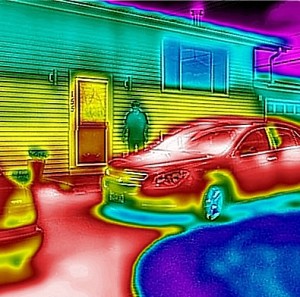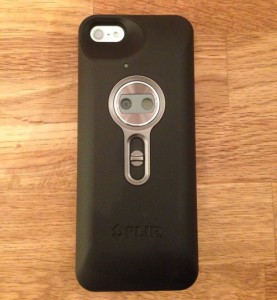TorchLight© “An Assistive Tool to Locate People and Objects with a Multimodal Thermogram Interface”
 The objective of this STTR phase II is to apply past NSF funded research to prove that a blind/low vision user can receive practical navigation and interaction information about their environment from multimodal thermogram (thermal image) interface on a smartphone. To address the challenge of creating an interface that both provides practical utility and that will be accepted by the target demographic, Moai Technologies will work with Dr. Nicholas Giudice, who is experienced in this field. NSF funded research conducted in his lab has led to extremely promising results in the development and evaluation of new vibro-tactile and auditory interfaces for supporting blind accessibility on touchscreen tablet and smartphone devices. Dr. Giudice will be conducting IRB approved human studies at his lab as part of phase I and phase II research. The outcome will be an innovative assistive device that uses heat radiated by people, machines and materials that retain heat to provide useful information to blind and low vision users. This capability is recently made practical by the commercial availability of low cost thermopile arrays. The NSF subtopic is “Robotics and Human Assistive Technologies G.3.”
The objective of this STTR phase II is to apply past NSF funded research to prove that a blind/low vision user can receive practical navigation and interaction information about their environment from multimodal thermogram (thermal image) interface on a smartphone. To address the challenge of creating an interface that both provides practical utility and that will be accepted by the target demographic, Moai Technologies will work with Dr. Nicholas Giudice, who is experienced in this field. NSF funded research conducted in his lab has led to extremely promising results in the development and evaluation of new vibro-tactile and auditory interfaces for supporting blind accessibility on touchscreen tablet and smartphone devices. Dr. Giudice will be conducting IRB approved human studies at his lab as part of phase I and phase II research. The outcome will be an innovative assistive device that uses heat radiated by people, machines and materials that retain heat to provide useful information to blind and low vision users. This capability is recently made practical by the commercial availability of low cost thermopile arrays. The NSF subtopic is “Robotics and Human Assistive Technologies G.3.”
 The societal benefit of this innovation is significant. The assistive use by blind people of thermal imaging could potentially be just as significant a tool as GPS and handheld computing have been.Thermal imaging can differentiate people and objects from their background without the need for complex image analysis. The shape and the temperature of the human body allows the location of people to be easily determined. In complex public spaces a blind person can use a smartphone’s haptic touchscreen display to examine the thermal image to determine the location of people in front of them. Information about the layout of an unfamiliar public space can be learned from the heat and shape of materials. Indoor spaces often have hot ceiling lights arranged in a regular pattern that defines the shape and size of the room. Most machines generate waste heat that can be used to locate them. Examples would be vending machines like ATMs and train passes.
The societal benefit of this innovation is significant. The assistive use by blind people of thermal imaging could potentially be just as significant a tool as GPS and handheld computing have been.Thermal imaging can differentiate people and objects from their background without the need for complex image analysis. The shape and the temperature of the human body allows the location of people to be easily determined. In complex public spaces a blind person can use a smartphone’s haptic touchscreen display to examine the thermal image to determine the location of people in front of them. Information about the layout of an unfamiliar public space can be learned from the heat and shape of materials. Indoor spaces often have hot ceiling lights arranged in a regular pattern that defines the shape and size of the room. Most machines generate waste heat that can be used to locate them. Examples would be vending machines like ATMs and train passes.
 The broader impact/commercial potential of this project will go beyond assistive use of thermal technology for blind users. This technology will have a societal impact by improving the quality of life and autonomy for the blind in the same way that Global Positioning System and handheld computing have. Information about the layout of an unfamiliar public space can be learned from the heat and shape of materials, which will assist blind users in work environments or everyday activities. With the global proliferation of smartphone usage and an aging population, the commercial market for this assistive product will continue to see strong growth in the future. After the technology for low cost thermal imaging on a smartphone has been developed, the market for sighted users could benefit from numerous related applications as well. For example, various commercial industries could benefit from low cost thermal imaging on a smartphone that can communicate data wirelessly through a cellular network. Industry examples might include: manufacturing, petrochemical installations, construction, electrical systems, food packaging, or agriculture applications. The commercial market for applications used by sighted people will likely exceed the commercial market for blind users.
The broader impact/commercial potential of this project will go beyond assistive use of thermal technology for blind users. This technology will have a societal impact by improving the quality of life and autonomy for the blind in the same way that Global Positioning System and handheld computing have. Information about the layout of an unfamiliar public space can be learned from the heat and shape of materials, which will assist blind users in work environments or everyday activities. With the global proliferation of smartphone usage and an aging population, the commercial market for this assistive product will continue to see strong growth in the future. After the technology for low cost thermal imaging on a smartphone has been developed, the market for sighted users could benefit from numerous related applications as well. For example, various commercial industries could benefit from low cost thermal imaging on a smartphone that can communicate data wirelessly through a cellular network. Industry examples might include: manufacturing, petrochemical installations, construction, electrical systems, food packaging, or agriculture applications. The commercial market for applications used by sighted people will likely exceed the commercial market for blind users.
Keywords: Blind, low vision, assistive, multimodal, vibro-tactile, haptic, thermogram, thermopile
Contact: Brian Hanzal (612) 353-4985moaitechnologies@gmail.com
